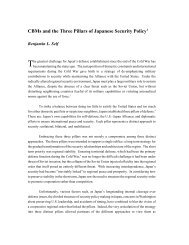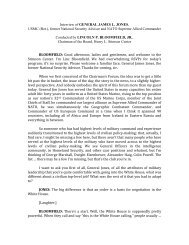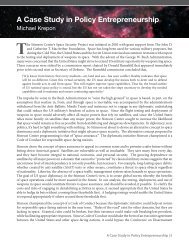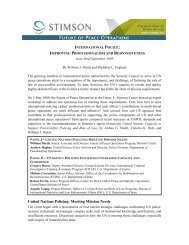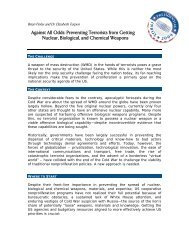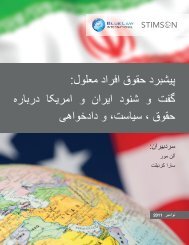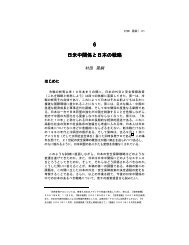India's Escalation-Resistant Nuclear Posture - The Stimson Center
India's Escalation-Resistant Nuclear Posture - The Stimson Center
India's Escalation-Resistant Nuclear Posture - The Stimson Center
You also want an ePaper? Increase the reach of your titles
YUMPU automatically turns print PDFs into web optimized ePapers that Google loves.
⎦<br />
⎣<br />
RAJESH M. BASRUR ⏐ 57<br />
far) non-deployed arsenal. On the other, as critics have pointed out, Indian<br />
nuclear doctrine is open-ended in its unhurried search for a range of capabilities,<br />
notably the development of a triad and the acquisition of missile defense<br />
capability. 2<br />
<strong>The</strong> essential features of Indian thinking about nuclear weapons may be<br />
outlined as follows: 1) nuclear weapons are not central to national security; 2) a<br />
nuclear arsenal does not require large, ready-to-use forces to deter an adversary;<br />
3) apparent imbalances in capabilities are tolerable; and 4) nuclear confidence<br />
building and arms control are desirable if strategic stability is to be obtained.<br />
Accordingly, in the nuclear era – which, if one excludes the 1974 test, dates<br />
back to the late 1980s, when India began to accumulate the first of its bombs in<br />
the basement – governments across the political spectrum in New Delhi have<br />
sought no more than a relatively small and non-deployed capability. Nondeployment<br />
greatly reduces the risk of crisis escalation, while tolerance of<br />
imbalances inhibits the long-term escalatory process of arms racing. <strong>The</strong> latter is<br />
complemented by a persistent interest in institutionalized restraint. It is notable<br />
that, unlike the United States and the Soviet Union, which came to the brink of<br />
nuclear war in 1962 before they began to build bridges of restraint, India and<br />
Pakistan signed their first nuclear-related confidence-building measure (CBM)<br />
not to attack each other’s nuclear facilities as early as 1988, when they had<br />
scarcely crossed the Rubicon of acquiring nuclear weapons.<br />
Might this change? As India’s nuclear edifice grows, the inconsistent<br />
elements in its doctrine could well be subject to pressures that cause New Delhi<br />
to drift away from nuclear minimalism to a more expansionary form of doctrine<br />
and practice. <strong>The</strong> pulls and pushes of newly perceived threats and organizational<br />
interests may be the drivers of change. Below, I assess the potentialities for<br />
change in India’s choices about nuclear hardware and posture, particularly with<br />
respect to the question of deployment. <strong>The</strong> appraisal is based on a series of<br />
interviews with individuals closely connected to policymaking conducted<br />
between mid-2003 and mid-2004. 3 I attempt to gauge whether policy makers<br />
today are satisfied with national deterrence capabilities, and whether they see a<br />
need for enhancing capabilities or changing India’s nuclear posture. Changes<br />
such as active deployment or competitive acquisitions are likely to invite<br />
strategic repercussions in India’s relationships with both Pakistan and China. I<br />
follow this up by assessing the prospects for change should environmental<br />
conditions be transformed.<br />
2<br />
See, e.g., P. R. Chari, “India’s <strong>Nuclear</strong> Doctrine: Confused Ambitions,” Nonproliferation Review 7,<br />
no. 3 (Fall-Winter 2000), pp. 123-135. Notably, official doctrinal statements do not even mention<br />
critical issues such as missile defense and the relationship between nuclear and sub-nuclear levels of<br />
conflict.<br />
3<br />
Because many of the conversations were conducted in confidence, I avoid citing names, with some<br />
exceptions. Of those that can be named, I owe thanks to Bharat Karnad, General V. P. Malik (retd),<br />
Rajesh Rajagopalan, Arpit Rajain, and Air Commodore Jasjit Singh (retd).<br />
⎤<br />
⎡



